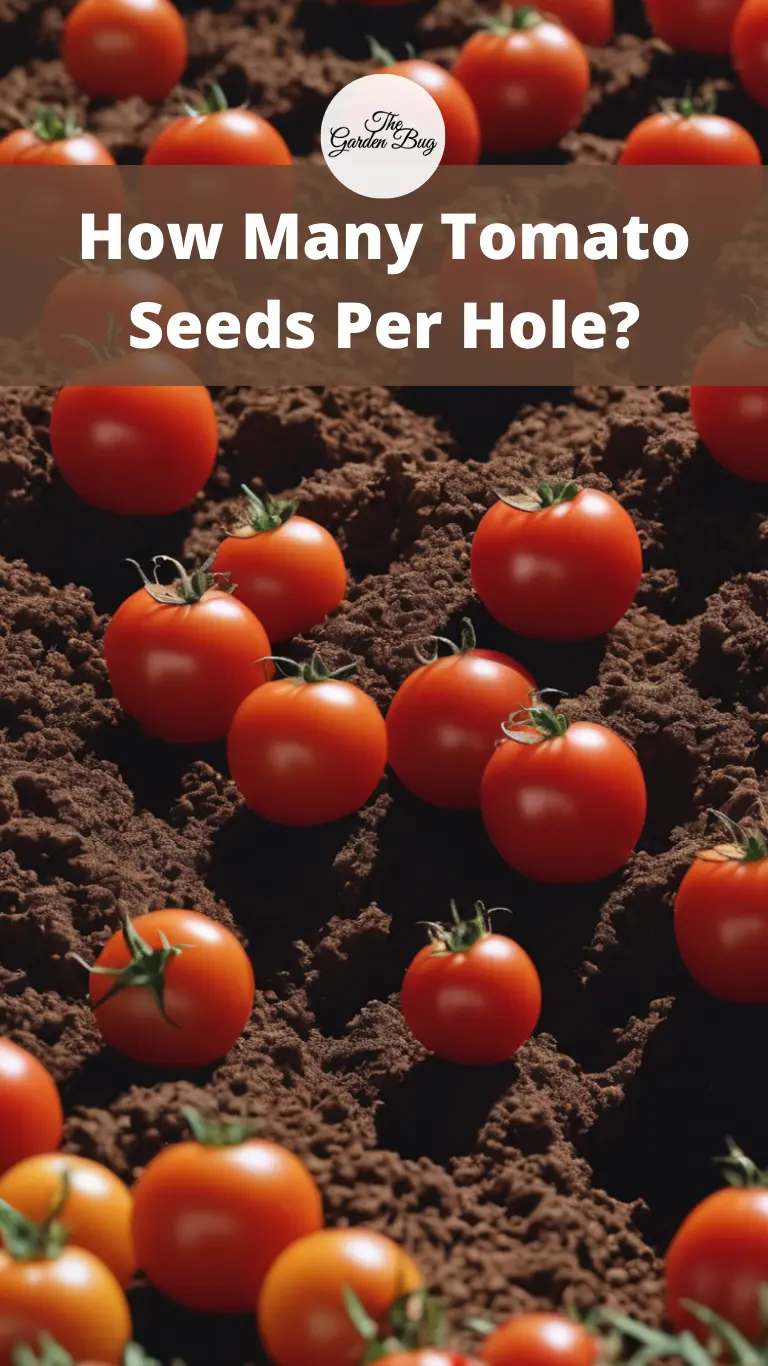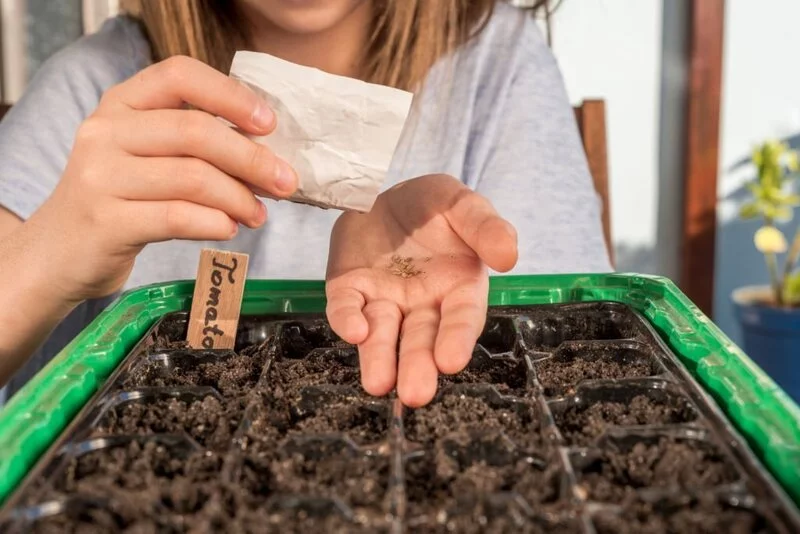Planting a garden can be a lot like baking a cake. You need the right ingredients, mixed in the correct amounts, to get the best results. But instead of flour and sugar, we’re working with soil, water, and seeds. Today, we’re rolling up our sleeves to delve into the world of tomato planting. We’ll uncover the secret to the age-old question: how many tomato seeds should you plant per hole? Let’s embark on this gardening adventure together!
- Name: Roma VF Tomato | Type: Heirloom
- Size at Maturity: 6 oz | Days to Maturity: 90 Days | Light Requirement: Full Sun
- Planting Time: Warm Season | Sowing Method: Start Indoors
- Planting Depth: 1/2″ | Plant Spacing: 18″
Understanding Tomato Seeds
Tomato seeds are fascinating little things. They might be small, but they’re packed with potential. Each tiny seed holds everything needed to grow a robust tomato plant, bursting with juicy, red tomatoes.
But how does a small seed turn into a big plant? This magical process is called germination. With the right mix of water, light, and warmth, the seed wakes up from its deep sleep and starts to sprout. It sends out roots to drink up water and a stem to reach towards the light.
However, not all seeds wake up. Just like some of us struggle to get out of bed in the morning, some seeds might not germinate. They might be too old, too dry, or just not quite right. That’s why gardeners often plant more than one seed in each hole. But how many is just right? Let’s dig in and find out in the next section!
Preparing Your Seeds
Before we dive into planting, let’s take a moment to talk about preparing our tomato seeds. This step is a bit like warming up before a big race. It gives the seeds a head start and increases their chances of sprouting successfully.
One simple way to prepare tomato seeds is by soaking them. Submerge your seeds in warm water and let them sit for about 12-24 hours. This soaking process wakes the seeds up, telling them it’s time to grow. After the soak, pat the seeds dry and they’re ready for planting!
How Many Seeds Per Hole
Now that we have our prepared seeds, it’s time to answer our main question: how many tomato seeds should you plant per hole?
The magic number is usually 2 to 3 seeds per hole. Why not just one? Well, remember when we talked about some seeds not waking up? By planting a few seeds in each hole, we increase our chances of at least one seed sprouting. It’s like having a backup plan.
But what if all the seeds germinate, and we end up with 2 or 3 seedlings in one hole? Don’t worry! Once they’ve grown a bit, you can carefully remove the extra seedlings and give the strongest one room to grow. This process is called ‘thinning out’.
By preparing our seeds and planting the right amount per hole, we’re setting up our tomato garden for success. But there’s more to it than just planting. Let’s talk about giving our tomato plants the room they need to grow!
The Importance of Spacing
Imagine trying to grow in a crowded room. It would be pretty tough, right? The same goes for our tomato plants. They need room to stretch their roots and soak up all the sunshine. That’s where spacing comes in.
When you plant your tomato seeds, keep each hole about 24 to 36 inches apart. This may seem like a lot, but tomato plants love to spread out. Giving them this space allows them to grow big and strong, without having to compete for resources like water, nutrients, and light.
Remember, a happy tomato plant is a productive tomato plant. Give them space, and they’ll reward you with a bountiful harvest!
Caring for Your Tomato Plants
Now that our seeds are tucked into their spacious homes, let’s talk about care. Just like a pet, our tomato plants need love and attention to thrive.
First, they need regular watering. The soil should be kept moist, but not waterlogged. Think of a well-wrung-out sponge, that’s the level of moisture you’re aiming for.
Second, tomatoes love the sun. Make sure your plants get at least 6-8 hours of sunlight each day. If you’re growing indoors, a sunny windowsill or a grow light can do the trick.
Last, but not least, consider feeding your plants with a tomato-specific fertilizer. This provides them with the extra nutrients they need to produce delicious, juicy tomatoes.
Taking care of tomato plants is a rewarding job. With each watering, each ray of sunlight, and each nutrient you provide, you’re helping create life. And the payoff? Fresh, homegrown tomatoes that taste like sunshine and hard work. Now that’s something to be proud of!
- Made with premium ingredients
- Contains compost, peat moss, aged bark and lime
- Great for improving and revitalizing the soil in and around your vegetable garden beds
- Naturally lightweight and contains just the right ingredients to grow plentiful, flavorful tomatoes and vegetables
- 20-quart bag
FAQs
What should I do if none of my seeds germinate?
Sometimes, despite our best efforts, seeds don’t germinate. It could be due to the seeds being too old, or not having the right conditions. If this happens, don’t be disheartened! Gardening is all about patience and persistence. Try again with fresh seeds, ensuring they have the right balance of moisture, warmth, and light.
Can I plant more than three seeds per hole?
While you can plant more than three seeds per hole, it may not be necessary or beneficial. It could lead to overcrowding if more seeds germinate, and you’ll have to thin out more seedlings, potentially disturbing the roots of the remaining plants.
How long does it take for tomato seeds to germinate
Tomato seeds typically germinate within 5 to 10 days, but this can vary based on the variety of the tomato and the conditions they’re in. Remember, patience is key!
Conclusion
From a tiny seed to a towering plant brimming with juicy tomatoes, the journey of a tomato seed is truly remarkable. By preparing our seeds, planting just the right number per hole, and giving them the care they need, we set ourselves up for a successful harvest. Remember, every great gardener has had seeds that didn’t sprout or plants that didn’t fruit. But with patience, perseverance, and a handful of tomato seeds, we can grow not just a garden, but also our abilities as gardeners.







